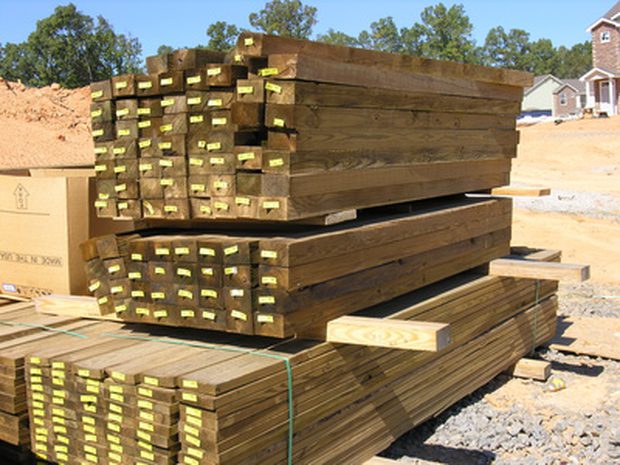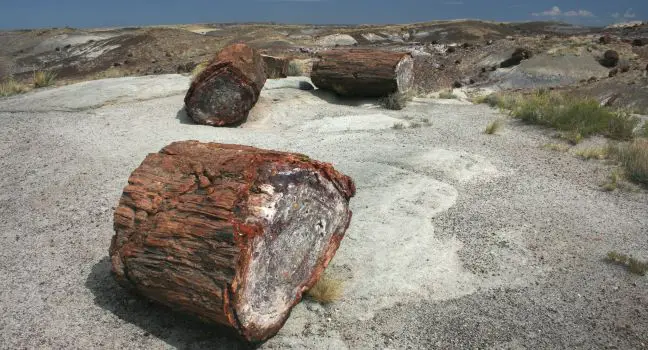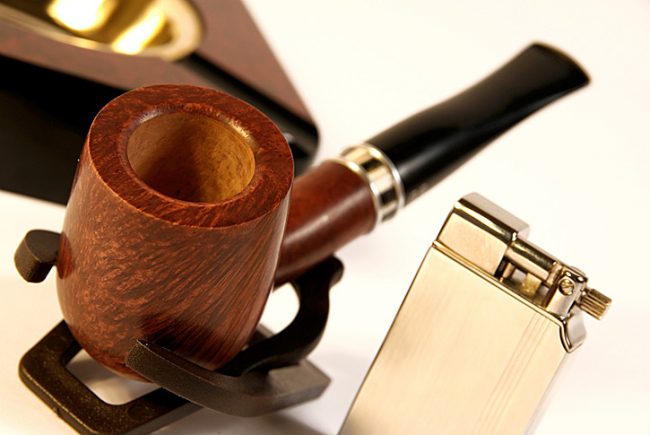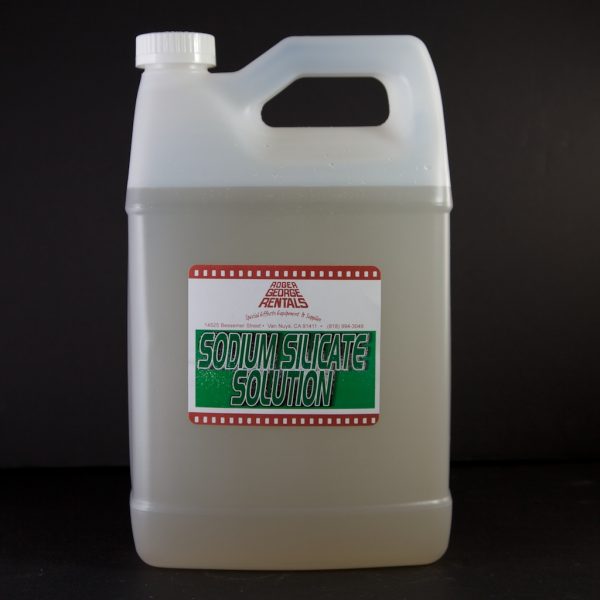Wood is one of the materials that has accompanied us in our evolution since ancient times. Unfortunately, due to its lower resistance to external factors, many of the monuments and constructions made of wood over the ages have deteriorated or been destroyed. Low resistance to fire and insect attack, rotting over time, are causes that have led to the disappearance of some buildings and have led specialists to think of ways to increase the resistance of wood. One way is to impregnate it with sodium silicate, an inorganic compound made from sand and caustic soda.

Making very hard wood by impregnating it with minerals is nothing new. The best known example is the Stone Forest in Arizona, USA, which I wrote about some time ago. So, in a nutshell, the story goes like this. Millions of years ago in Arizona there were vast pine forests. After a catastrophic catastrophe, whole trees, very tall and thick-trunked, fell to the ground. Salt-laden waters flowed through and over them, replacing some of the woody material with salts that settled perfectly into the wood's internal structure. The appearance of the wood remained virtually unchanged, but it became... stone. The section shows the annual rings and other structures typical of wood.

Another example of naturally hardened wood are the pillars supporting the buildings in Venice. Venice was built as a fortress against barbarian attacks. But being in a lagoon on swampy land, architects had to find sustainable building solutions. They ended up building on wooden pillars. Basilica Santa Maria della Salute is said to have been built on more than a million wooden pillars. Over time, due to the salts in the water, they became petrified and still support the buildings without any problems.

The mixture of sand and soda (lye) has been known since the 1800s when it was used as a detergent and later, in the 1900s, to preserve eggs. Sodium silicate, also known as glass water, is used for impregnating wood to increase its resistance to rot, fire and insect attack.
Industrially, the wood is treated in autoclaves with a silicate solution, under pressure or in a vacuum, so that the impregnation is as deep as possible. The pressure can reach 6-7 atm. After impregnation the wood is heated to 44-45 grd.C so that the water evaporates and the salts remain. Basically, the inner fiber of the wood remains wrapped in a transparent glass bead, which makes it much more resistant to fire, all kinds of beetles and rot.

Treating wood with silicate makes it much harder. Studies have shown that treated wood becomes 401TPTP3T harder than untreated wood. Thus, treated pine wood becomes as hard as oak.
There are substances that can be used to treat wood by hand without the need for autoclaves. They can be applied with a brush or by spraying. Of course, the results will not be the same as when the wood is impregnated and the substance goes deep inside, but it still provides protection. 40% silicate solutions are used. Both sodium and potassium silicate 40% solutions are used for fire protection. Such treated wood will not be totally fire retardant but will burn more slowly.

Glass water treatment protects wood against moisture and is recommended for wood used for decking. The wood is also treated to protect against moisture. The heat developed inside the pipe turns the silicate film into a hard bead that prevents water penetration.

The silicate-treated wood used in construction is highly resistant to insect attack, even by the very aggressive and resilient wood-boring beetle. The great advantage of silicate treatment is that it is non-toxic like the other substances (arsenic derivatives) commonly used as wood preservatives.
Sodium silicate has other uses. It is used in the automotive industry for various repairs, as an adhesive, in aquaculture, in food preservation (silicate-treated eggs last 9 months), fire protection, concrete treatment, refractory materials, and for reinforcing walls in boreholes. It is increasingly replacing toxic wood-treating substances.


































Is it possible to treat wood in this way with a normal immersion in a solution tank? In the absence of conditions to achieve high pressures / vacuum. What would be a recommended duration for such a "soaking". THANK YOU
I haven't tried it, but I'm thinking that if it can be applied with a brush, there would be no problem for immersion. I think the wood can be left for 24 hours in a vat of solution. It will absorb more solution the drier it is. After that it should be left to dry again. Again, just an opinion, I've never tried it. But I'm thinking there's nothing to spoil. Take care when drying. Don't force it because it can cause tension and the wood can crack.
Good luck!
I would like to treat a terrace, near the water, made of fir pole. I thought of giving them (the posts) with glass water and linseed oil. Reading the comments I don't know how to do it. Should I first give with oil and then with glass water or vice versa? Does the linseed oil work with the bottle water? Or will I be surprised if the oil doesn't get into the wood if I use water first...or if the water doesn't get in because of the oil? I'm waiting for your advice. Thanks!
Hello!
Apply glass water first. It is more fluid and penetrates deep into the wood, blocking absorption. It is also useful as an antique protection. After application and drying, the wood should be film-free. Then apply the oil. Absorption will be lower, but you will have surface protection and a pleasant appearance. The oil will wear off over time, washed away by water and rain. You will have to re-finish (oil coat) after 1-2 years.
All the best!
Hello,
And what do you recommend for the longest possible protection of wood?
What if after the above mentioned glass water then linseed oil and then one year after the linseed oil is well impregnated we apply varnish? Is it more ok? Or what is the best option to protect wood outside (fence, terrace).
All the best!
Good evening!
My favourite is the Kreidezeit oil-based lard. It needs refreshing after 4-5 years, depending on how exposed the fence or patio is. But refreshing is done simply, without sanding or removing the old coating.
There are also systems on the market that manufacturers say will last 12-15 years. They are usually water-based varnishes and the technology and application method must be respected to achieve such resistance. The disadvantage is that if it starts to crack and peel, the whole old layer has to be removed before applying a new layer of protection.
Glass water will reduce the absorption into the wood for the materials applied on top and make them less resistant over time. It may be that the oil will be completely washed off the wood within a year (linseed oil will surely be washed off by rain). Alkyd varnish or anything oil based should be applied over an oiled surface so it has no adhesion.
Below is a link to an article that elaborates on the exact subject of exterior finishes and their resistance. I hope you find it useful.
Good luck!
https://revistadinlemn.ro/2022/05/19/ce-variante-ai-pentru-protejarea-lemnul-folosit-la-amenajarile-exterioare/
Does the wood still breathe after the glass water treatment, i.e. is there still vapour diffusion to the wooden walls?
After using this treatment, can varnishes, lacquers, etc. be used?
If the treatment was done industrially, in autoclaves, as is the case with the wood for decking sold by specialized stores, it can be covered with exterior lacquers or varnishes. If the treatment is done at home, with a brush, the staining should be done before the silicate treatment, and nothing else should be applied over the silicate, as it acts as protection.
All the best.
For a solid wood fence, when is it appropriate to apply the treatment?
-when the wood is still "visible";
-or the wood to be dry.
Where can I buy this solution for treatment?
Thank you very much!
green, dry
Hello,
Wood for fencing can be treated. Makes it more resistant to rot and insect attack.
The wood must be dry to absorb as much as possible. The most resistant is dry wood impregnated under pressure and then heated to 40-45 degrees.
If you want to protect the wood in a "domestic" way, use dry wood, untreated with other substances before. If you want to change the natural color of the wood, you have to stain the wood before applying the silicate solution because after that the wood will not take the color. Apply the solution with a brush, several coats to absorb as much of the solution as possible, then allow to dry. Do not varnish the treated wood.
You can find silicate in DIY stores. Silicate is used as an additive in concrete.
All the best!
Nice and useful your comment. I would have something to ask, for staining wood prior to treatment, is water based bathing good? I suspect that the best would be the water-based bath.I intend to use surface burning of wood for exterior doors I would like to know if I can apply two coats of sodium silicate and how to dilute the silicate, to 600ml of water I put 400ml sodium silicate.Application I will do with a paint gun or with a paintbrush, the technique with pressure or vacuum are not within my reach. Thanks in advance.
Good evening,
And I think the best is water-based bathing. Resin-based can reduce or even block silicate absorption.
If you're burning it why do you want to treat it with silicate? Burning protects and stains the wood.
As I wrote in the article, 40% solutions are used for wood (100 g solution, 40 g silicate).
All the best.
Thank you, I intend to apply silicate treatment to make it waterproof, I noticed that the lacquer either for outside degrades, that is it matures (turns white), while the sodium silicate I suspect does not.
First of all, before applying the silicate, the wood must be thoroughly wetted. If you do not wet the wood the penetration will be superficial. The silicate is diluted 1 litre concentrate to 5 litres of water. The commercial one is diluted in various proportions. The density of the concentrate is around 2.4. Weigh.
Keep in mind that if the wood has tannin it will react with the silicate and take on a reddish to dark brown hue. Diluted silicate is applied in as many layers as necessary until it forms a waterproof layer on the surface. Dry wet-on-wet. When the wood is no longer absorbent, wipe off the excess thoroughly with a damp cloth.
Only after the silicate treatment do you bathe with anything. The varnish I recommend to be alkyd even if it dries harder.
As extra protection you can add a grain antifungal that you can find at phytosanitary. Be careful with the concentration. Measure with a pipette. Add it to the silicate.
Sorry. The density of the concentrate is approximately 1.4.
Hello.
Can glass water be applied on stone roads, or those made of "asphalt milling"? In the mixture with the sand in that milled ballast does the glass water bind a little bit enough to protect it from heavier rains?
Thank you.
I need a suggestion for the following case:
A cabin made of resinous wood with long beams protruding outside to support small balconies. Some areas of the beam from the exterior around the nails show signs of decay. The rot does not extend over large areas and has not reached the wood wall. What remedial solutions can I apply? Here I am referring to both mechanical, removing the diseased wood, and chemical, impregnating.
I give a few examples of substances I have heard about but know nothing about:
- Bios Wood Total (impregnant marketed by "Casa Iancu" (?) - cedar oil and quartz stone)
- Bochemit Optimal Forte (impregnant with Cypermethrin, Alkylbenzyldimethylammonium chloride, Propiconazole, Tebuconazole)
- even Sodium Silicate (but I understand that this one is filmic).
With thanks,
Sodium silicate is used to treat wood but together with other insecticides.
and fungicides -. Do not treat wood used outdoors with simple silicate. Treated wood
with silicate will be used indoors, in low humidity conditions, away from moisture. Who claims
that it can be used outside does not know anything about sodium silicate, are gratuitous statements.
It is worth mentioning that the treatment with sodium silicate is repaired after 5 years at the most.
How do you treat wood on the outside if simple silicate/glass water does not arrive?
Do you know how much Silicate is needed for a 5 m/w wood surface?
Hello!
The solution consumption is 100 ml/sqm/layer. Depending on the type of product and concentration 1 or 2 coats can be applied.
All the best!
Hello,
I want to install a dry pine deck, now the interesting part is: what is the best way to protect it?
I don't care about a certain solution, I care about what would be the best solution.
I thought I would paint it with polyurethane paint on the "belly" and oil on top;
or
to give it with glass water and then with oil,
I don't have a preconceived idea, but I really don't know and I'm fed up with 'specialists' who only want to sell their product whether it is the recommended one or not.
Hello!
For decking, the best solution from my point of view is oil, applied on both sides (i.e. also on the belly). Polyurethane paint can peel off and you lose protection. Also, the finish is unbalanced and can warp the wood. Look for special deck oils that are both exterior and traffic resistant.
Glass water strengthens the wood and makes it resistant to insect attack. Care must be taken when applying the wood to ensure the right amount is absorbed. The wood must not be saturated because it can no longer absorb oil.
You can also just use oil. Tung oil or Danish oil are good solutions. Also synthetic oils specially formulated to withstand the outdoors and traffic. Saturate the wood well with oil, water and rot resistance comes from within.
Good luck!
Hello.
I made a wooden fence 60 m long by 1 m wide
What solution do you recommend for his treatment, especially anti-fog?,
Thank you
Good evening!
In my opinion the best option for protecting fences is oil-based varnish. Even if it does not have the same resistance over time as outdoor varnishes, it is much easier to maintain and restore.
More information on fence protection and construction can be found in the articles below.
All the best!
https://revistadinlemn.ro/2018/03/09/garduri-din-lemn-cum-se-alege-lemnul-materiale-de-protectie-sfaturi/
https://revistadinlemn.ro/2020/04/30/de-ce-gardul-facut-de-bunicul-meu-a-durat-50-de-ani/
Hello
I have given the wood on the terrace with Haresil Argentum (sodium silicate), after six months you can see how the wood has taken water and started to crack and make a white dust, especially on the beam and posts, parts exposed to sun and weather.
Now I'm thinking TB to change the whole terrace because that dust is very toxic and especially for children. What can I do in this case. No one wants me to sand it, and from what I understand nothing else will stick to it.
Is the white dust it makes toxic or not?
Do you know anyone who can help me?
It is very expensive to change the whole terrace.
Good evening!
It would have been good to apply 2-3 coats of oil-based varnish as well.
Indeed, silicates are not good for you. It's important not to be aspirated, it's bad for the lungs.
The presence of dust on the outside shows that the wood has been over-impregnated, but the water has started to draw the silicate out as a solution. When the water evaporated, the white silica salt dust (silicate) remained.
I would try to hose down the deck very thoroughly, then do a light wet sanding and apply 1-2 coats of oil-based varnish or water-based exterior varnish to set the silicate inside the wood. Just a suggestion, I have not dealt with a similar situation. But I'm thinking it's worth a try before you consider redoing the whole deck.
Good luck!
Hello! Do you know if glass water can also be used to treat old wood that shows signs of decay? I have beams in my house that are partially damaged and I want to treat them with a non-toxic solution.
Good evening!
Yes, it can be used, it is even recommended because it strengthens weather-beaten wood.
I recommend Holzwurmfrei from Leinos. It is a natural product - a mixture of silicates - specially made to fight decay and to be used on old wood.
All the best!
Thank you for your answer!
On a dried and planed beam, if I immerse it in a glass/silicate water bath so that the wood absorbs well for a few days and then remove it and leave it to dry, will the beam keep its original shape? Will it be straight or warped?
If the beam has been dried before and has not deformed during this process, it will not deform after impregnation in the silicate bath followed by drying.
After full impregnation of the beams in the silicate bath, how long should I wait for them to reach the humidity of 12% again (in the open air)?
Depending on how well the drying area is ventilated (air currents), the humidity of the environment and the outside temperature, it can last from a week to a month. If the outside humidity is high, the moisture content of the wood may not fall below 14%.
Hello,
For a fence that I have treated with a waxed outdoor waterproofing, can it be treated additionally with "glass water"?
Thank you very much
Hello!
If you've been treating it for a short time, it can't be. Wax prevents water from penetrating the wood, and silicate is a water-based solution. But after a while - a few months, a year or two, depending on rainfall and the quality of the treatment applied - the wax impregnation is 'washed away' by the rain and can be treated with silicate solution. It is important that the silicate solution is absorbed by the wood.
All the best!
Hello!
The footings of a wooden house (those that sit directly on concrete) can be treated.
with sodium silicate as a hydrophobic treatment?
Good evening!
Sodium silicate protects primarily against fire and insects. But it is also a good protection against water because it forms a protective layer on the surface of the wood. To increase water resistance also treat with linseed oil after the silicate.
good day
what should I put in the sodium silicate to harden it?
Good evening!
Sodium silicate is a salt, it does not need a hardener. By evaporating the water (drying), the sodium silicate in the solution that enters the wood becomes solid and hardens the wood.
Hello, what other solutions can be added to glass water (diluted 60-40) to better protect against insects/moisture? Thanks
Hello!
Against insects, borax (sodium borate), permethrin (solution against rabies and lice) or concentrated wood retreating solutions (Bochemit prevention) can be added. For good outdoor resistance, the wood can be impregnated under pressure with Tanalith (solution of copper and organic biocides). I don't think, however, that without pressure it will get into the wood enough for good protection.
Against dampness it is recommended to apply to the wood after impregnation with glass water, oil or an exterior resistant protective varnish.
Good luck!
https://revistadinlemn.ro/2017/09/08/despre-cari-motivul-aparitiei-ciclul-de-viata-preventie-tratamente/
https://revistadinlemn.ro/2018/08/23/tratamente-naturale-impotriva-carilor/
https://revistadinlemn.ro/2020/08/27/tratament-preventiv-impotriva-ciupercilor-mucegaiului-si-a-insectelor-care-ataca-lemnul/
https://revistadinlemn.ro/2019/06/25/impregnarea-prin-presiune-in-autoclava-creste-rezistenta-lemnului-se-face-si-in-romania/
Hello, what do you recommend for long-term protection against woodworm? The attic is made of untreated and unfinished wood. I want to enclose it with glass wool and plasterboard and will not have access to the wooden structure. Thank you.
Hello!
You can use glass water, provided the wood is well coated on all sides. Holzwurmfrei is a silicate-based protection product. It is natural, with no health risks. I leave a link below to an article where you can find more information.
A very effective option is Bochemit prevention. It is a variant with very good results over time, but it is a chemical product and must be applied carefully. I leave the link to it.
Good luck!
https://revistadinlemn.ro/2018/08/23/tratamente-naturale-impotriva-carilor/
https://revistadinlemn.ro/2020/08/27/tratament-preventiv-impotriva-ciupercilor-mucegaiului-si-a-insectelor-care-ataca-lemnul/
Hello. I applied undiluted sodium silicate from Axton on some previously sanded planks. Can I apply alkyd clear varnish over ? Can the traces of silicate drops be sanded?
When I tried applying glass water over a coat of clear varnish I noticed a darkening of the wood's hue. Is it tannin, reaction... Can you send me a phone number to send you a picture on whatts up. thanks in advance.
Hello!
If the silicate has not formed a clump on top, it can. If there are white spots or a glassy flake, it needs to be sanded beforehand. Otherwise the varnish does not adhere to the wood and the film comes off.
Yes, the droplet marks can be sanded off.
The tannin only came out if the glass water reached the wood. On tannin wood, such as acacia, stains can appear on contact with water-based products because tannin dissolves in water. You can send photos to mihaela.radu@cesbrands.ro.
Does wood treated with glass water still breathe respectively, does it retain its vapour diffusion capacity (up to 5)?
Glass water makes the wood denser (the treatment is suitable for weathered old wood) and more resistant to moisture. Water vapour exchange with the environment is greatly reduced.